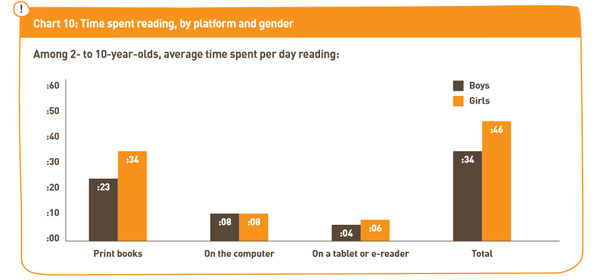
In a recent national survey of parents of young children (ages 2-10), researchers asked parents how much time their kids spent with educational media across different formats and what their kids learned, as well as about their kids’ reading behaviors. (“Educational media” was defined as media the parents thought was “good for their child’s learning or growth or that teaches some type of lesson, such as an academic or social skill.”)
Overall, parents said their children spend just over 2 hours a day (2:07) with screen media, with 44% of that deemed “educational” by the adults. The amount of time spent with educational media decreased as age increased, with the youngest group, ages 2-4, spending 1:16 hours a day and the oldest group, ages 8-10, spending just 42 minutes. As might be expected, TV was the dominant form of educational screen media, with three-fourths (76%) of all educational media in a given day being streamed through a TV.
Parents were also asked to indicate what their children learned by using educational media. Among those who used it weekly, more parents said their child learned “a lot” about cognitive skills and reading/vocabulary (both 37%) and math (28%) than science (19%) or the arts (15%). Interestingly, format mattered: More parents said their child learned a lot from educational TV than from mobile devices. The children who use educational media weekly are also doing something about the media they view: Their parents said they talk about what they saw or did (87%), engage in imaginative play about it (78%), and ask questions about it (77%). Even better? Three of 5 parents (60%) said their children taught them something about what they saw or did.
This group of 2- to 10-year-olds spent an average of 40 minutes a day reading or being read to, of which 29 minutes were spent on print books, 8 minutes on a computer, and 5 minutes on an e-reader or tablet. The amount of time parents and children spent reading together decreased as age increased, with 2- to 4-year-olds spending 44 minutes co-reading and 8- to 10-year-olds spending 24 minutes co-reading. Differences in reading time were not statistically significant based on race, income, or parent education, or among the age groups; however, there was a significant difference in children’s gender, with girls reading for 46 minutes a day and boys reading for 34 minutes, on average.
Read more about how families are interacting with educational media—or choosing not to—in the full report. This rich report also breaks down the topics by race/ethnicity, education level, and family income to gain deeper insight into how parents view educational media.
Libraries: how do you connect families with educational media resources? Let us know by chatting with us on Twitter.
Note: This post is part of our series, “The Weekly Number.” In this series, we highlight statistics that help tell the story of the 21st-century library.